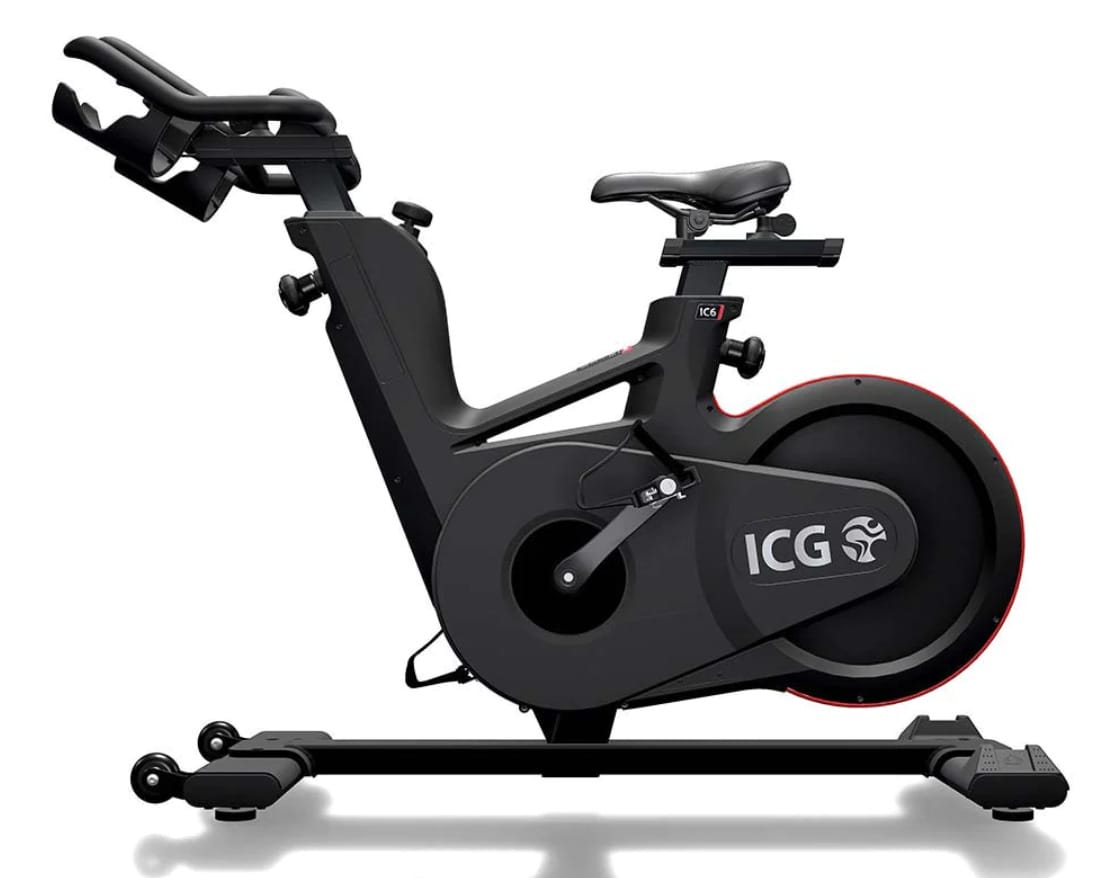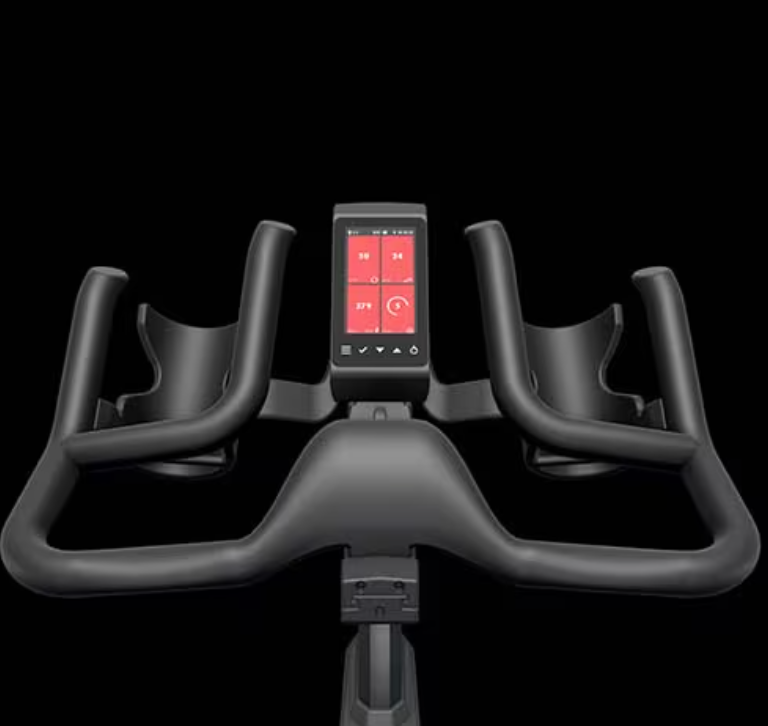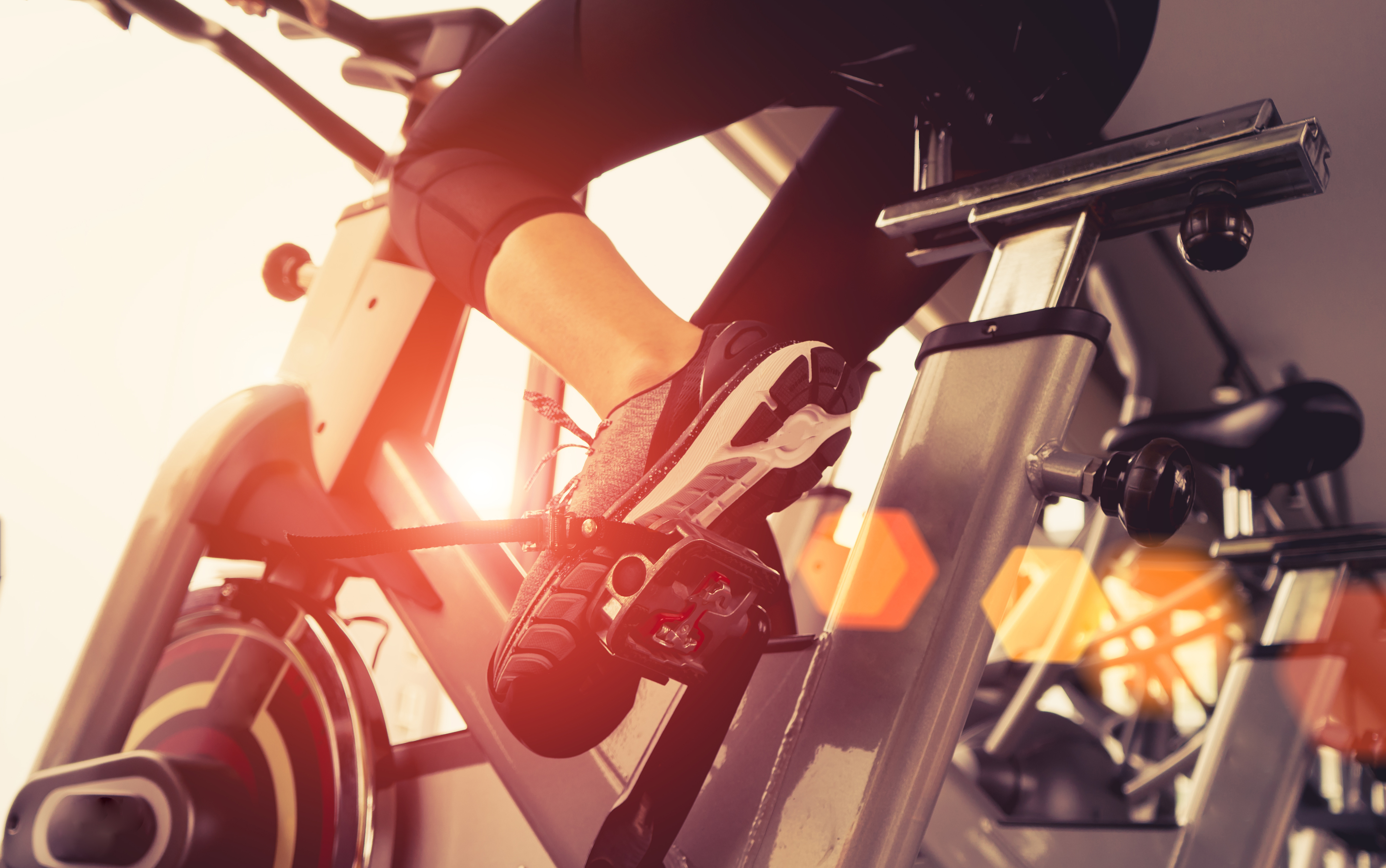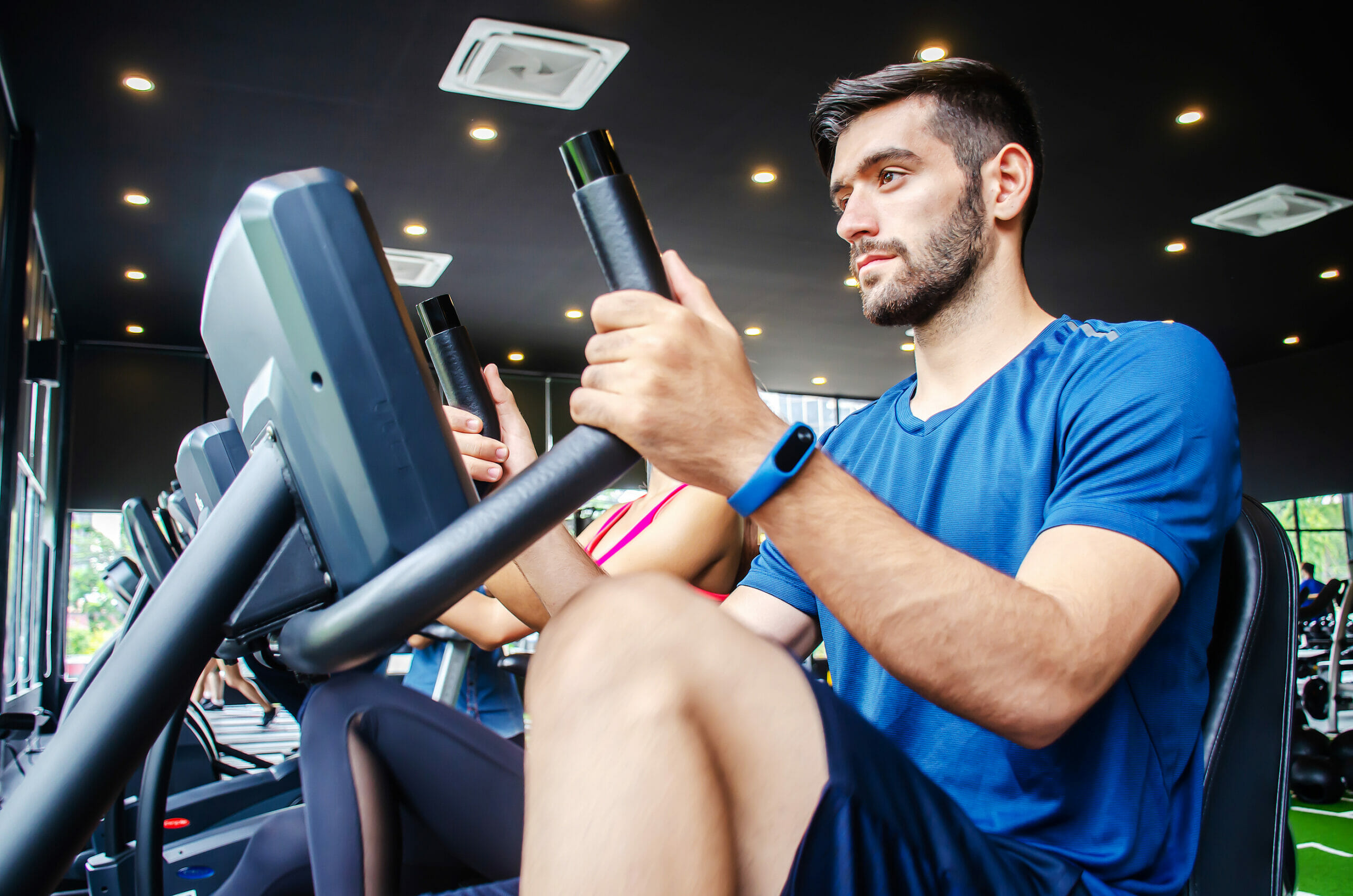
Now that Life Fitness has acquired ICG, they get to use their elite cycles to fill out their cardio lineup and personally, I see this as a match made in heaven.
Life Fitness is a brand well-known for their commercial fitness equipment, but they also offer a fairly wide range of machines designed for home use as well.
With impressive specs and high-tech features, the IC6 Indoor Cycle is a great example of what we should expect from such a prestigious company.
It also just so happens to be a strong contender for one of the best indoor cycles out there.
Highlights include a fast-spinning, rear-mounted flywheel, a heavy-duty frame, and a sophisticated console that accurately measures watt output.
The result is an elite cycle designed for optimal performance – but that said, this is a competitive price point.
With brands like Keiser out there, it’s hard to decide whether or not the IC6 is really worth the investment.
Luckily, I’m here to help.
In this review, I’ll go over everything the IC6 has to offer, but I’ll also try to compare it to some of the other top cycles in its price range.
After reading, you’ll know whether or not this bike is worth buying.
With a robust frame and smooth acting resistance system, the IC6 can hold its own with any indoor cycle in its price range. Folks looking for an elite cycle geared around measuring and improving performance are unlikely to be disappointed.
Life Fitness and ICG
If you’ve worked out in a commercial gym anytime in the last few decades, you’ve probably used a Life Fitness exercise bike or treadmill.
They’ve become one of the more popular commercial fitness equipment providers, but it certainly wasn’t an overnight success.
Life Fitness technically started about 45 years ago with the Lifecycle exercise bike, which was also the first electronic piece of fitness equipment.
“Lifecycle” was the name of the company for several years while they specialized in exercise bikes. The name was changed to Life Fitness in the ’80s after Bally Total Fitness purchased the company.
Years later the company was purchased by Brunswick Corporation, and long-story-short, they diversified.
With the acquisition of a few other companies, Life Fitness started producing treadmills and strength training equipment.
Nowadays, the company offers a wide range of cardio and strength training equipment for both commercial and home use.
Life Fitness has become a well-known brand over the years because of their reputation for creating high-quality products, which makes them a great fit for ICG.
ICG, or Indoor Cycling Group, has become one of the largest manufacturers of indoor cycles in the world.
They’ve also gained accolades for their impressive cardio machines and are known to offer some of the best exercises bikes around.
Well, when Life Fitness’ parent company acquired ICG, it allowed them to start filling their indoor cycling lineup with ICG’s bikes.
The result is a stellar lineup, packed full of high-end cycles.
The ICG IC6 Indoor Cycle

The IC6 is one of Life Fitness’s higher-end models, with only the IC7 sporting a higher price tag.
At first sight, the IC6 is a sleek looking cycle that looks as if it would fit in just fine somewhere in a cycling studio with 20 or 30 of them lined up in symmetrical rows.
I’m a fan of the black on black color scheme and the red detail around the flywheel housing certainly pops.
The next quality that stands out to me is how robust the frame and components appear, but more on that later.
Again, it looks like a bike you would see in a commercial gym.
As I’m writing this, the ICG IC6 is priced around $3200, making it quite pricey for a home indoor cycle, but you know what they say about getting what you pay for…
Pros
- Quiet, magnetic resistance system
- Lightweight flywheel
- 1:10 gear ratio
- Maintenance free belt drive train
- Fully adjustable seat
- Fully adjustable handlebars
- User assist feature to make adjusting handlebars easier
- Heavy duty frame
- 330 lb weight limit
- Dual sided pedals
- Self-powered
- Coach by Color console
- Solid warranty
Cons
- Pricey
Resistance
The resistance system is a good place to start when discussing any indoor cycle.
And when it comes to flywheels, most riders will tell you heavier is better, because it gives you a smoother, more fluid feel.
Most nice indoor cycles come with flywheels that weigh anywhere between 30-50 lb, although the folks at Keiser would disagree- they only use an 8 lb flywheel on their M3i Studio Plus.
The folks at ICG agree with the Keiser school of thought- that is, if you have a high-quality magnetic resistance system and a proper gear ratio, you don’t need a heavy flywheel to achieve a smooth pedaling motion.
The IC6 utilizes a 7.6 lb flywheel (which is considered very light in the spinning world) and users seem to be happy- there aren’t many complaints when it comes to the smoothness of the IC6.
The design of the gears and the automotive grade Poly-V belt drive enable the flywheel to reach high speeds, which makes for such a smooth feel.
More specifically, with a 1:10 gear ratio, that means the flywheel is spinning about 10x for every full rotation of the pedals.
That makes for a really fast moving flywheel.
Combined with the frictionless magnetic resistance, you get a smooth, nearly silent ride experience.
The awesome thing about having a belt drive system is that it’s maintenance free – unlike chain drives, you don’t have to worry about lubricating belts.
They’re also quieter than their chain counterparts.
The same goes for magnetic resistance- since there are no touching parts to create the resistance, there’s less risk of breakdown.
The IC6 uses a micro-adjustable magnetic system where the resistance settings are adjusted by turning a dial located front and center.
This gives you a lot of control to fine tune the intensity of every workout.
You also probably noticed that the flywheel is in the rear of the IC6.
This is a popular design element that Keiser started -not only does it look cool, but it actually protects your flywheel from sweat damage.
Overall, the IC6 utilizes a sophisticated magnetic resistance system with a belt drive train and lightweight flywheel to deliver an exceptionally smooth, quiet ride.
Seat
The important thing to consider when looking at indoor cycle seats is how adjustable they are.
A cycle at this price point should be fully adjustable, meaning you can change both the height and horizontal (fore/aft) position of the seat.
The IC6 does come with a fully adjustable seat, giving you the ability to find the perfect fit for your ride.
Bicycle seats are known for being uncomfortable, especially for novice riders. That said, users find the IC6 to be comfortable.
ICG has labeled the included seat a “sport saddle”, but it looks pretty standard to me.
The good thing though, is that if the seat is too uncomfortable, you can swap it out for another seat or throw a gel cushion on it for extra comfort.

Handlebars
The IC6 comes with fully adjustable handlebars, giving you the ability to adjust their position to fit you perfectly.
The handlebars are also multi-grip, which means you have plenty of options for where you decide to rest your hands.
The curvy nature of the handles should add a little comfort as well.
Something I never realized until I started riding regularly, was how much pressure goes through your upper body on an indoor cycle.
It’s important to change your grip up regularly to relieve pressure.
You also need to use different grips based on the type of workout you’re doing (sitting vs standing, climbing a hill, etc).
A great feature ICG has included on the IC6 is the “user-assist post”, which makes it a lot easier to adjust the height of the handlebars.
Making this adjustment is kind of difficult on most bikes because this post is heavy, but on the IC6, it’s a lot easier though because of this user-assist feature.
Frame
This bike comes with a heavy-duty steel frame.
All the internal components are hidden and guarded, which works well for design reasons, but also keeps everything protected from damage.
This sturdy frame has a max weight capacity of 330 lb, which is impressive considering most indoor cycles max out around 300 lb.
This shows that the IC6 really is built tough, just like their commercial grade machines.
With a weight capacity this high, this bike will be able to safely accommodate most users.
The IC6 has the following dimensions when fully assembled: 52″ (L) x 20.5″ (W) x 42.7″ (H).
This is a little long for an indoor cycle, but it makes for a more spacious feel.
I also want to point out that this cycle weighs in at a robust 112 lb, which is impressive for any indoor cycle, but even more so for one that comes with an 8 lb flywheel.
Personally, I like to see a heavy bike because it makes for a more stable feel during use.
And with an assembled weight this high, you won’t have to worry about the IC6 feeling flimsy or shaky during use.
Pedals
Most high-end indoor cycles are compatible with riding cleats and if you’ve never used cleats on a bike before, they definitely add to the experience.
They allow you to pedal faster and more efficiently.
Of course you have to purchase them separately if you don’t already own a pair.
The nice thing about the pedals on the IC6 is that they are dual-sided.
One side is compatible with SPD cleats and the other is a toe cage that works with sneakers. Regardless of which type of shoe you want to wear, these pedals will be compatible with you.
ICG reports that this bike has a 155 mm Q-factor, but unless you’re an avid cyclist, you probably don’t know what that means.
The Q-factor refers to how far apart the pedals are and the general idea is that having them closer together puts less stress through your knees and hips.
From a physical therapist’s point of view, this makes sense I guess.
But personally, I’ve never been on an indoor cycle where the Q-factor was so large that it was noticeable to me.
I think my point here is that experienced cyclists will appreciate this fact, the rest of us probably won’t notice.
Console
The IC6 comes with ICG’s WattRate TFT Computer 2.o, which is a real mouthful, so I’ll simply refer to it as the ‘TFT’ from now on.
Anyway, this console is pretty neat.
First of all, it’s self-powered, meaning that there’s a small generator on the bike that produces electricity as you cycle- your workout actually powers this console, no batteries or wall plug necessary.
Second, the “wattrate” part is referring to a sophisticated watt meter ICG developed to give you a precise measurement of your work.
This is paired with their “coach by color” system to let you know which workout zone you’re in.
Similar to other systems that use heart rate zones to determine your effort, this console will change the color of its screen based on your effort (which is derived based on your wattage output).
The TFT console is sleek and simple to use and it shows all the usual workout metrics we’d expect.
You can choose between 4 different display views during your workout.
This console is also compatible with heart rate monitors and bluetooth compatible with fitness apps.
Overall, this is a pretty sophisticated console, especially for folks looking to improve their performance.
 Warranty
Warranty
The IC6 comes with the following warranty from Life Fitness:
- 5 year frame
- 3 year mechanical parts
- 1 year other parts
- 1 year labor
This is a pretty good warranty for an indoor cycle and very comparable to what the other high-end bikes are offering.
Five years is pretty standard for the frame, matching what brands like Peloton offer.
NordicTrack does offer 10 year frame warranties on their cycles, but Keiser only offers 3 years, so there’s that.
3 years for parts is also quite good, matching what Keiser offers and surpassing the 2 years NordicTrack offers.
One year on labor is pretty standard.
Overall, a pretty solid warranty.
Final Thoughts
The IC6 Indoor Cycle is a great example of what we should expect from a high-end exercise bike.
With impressive specs and high-tech features, the IC6 is arguably one of the finest indoor cycles out there.
I love the lightweight flywheel and I really appreciate the heavy-duty frame this bike is rocking.
There’s really not much to complain about here except for the price.
There’s no denying that this is an expensive bike, but the real question is whether or not it’s worth the cost?
The only way I know to answer that question is to compare it to some of the other comps in its price range, so we might as well do that now.
The most obvious comp that comes to mind is Keiser’s M3i Studio Plus, which is priced almost identically at around $3200.
The M3i is very similar, in that it also utilizes a fast-spinning, lightweight flywheel, a sophisticated magnetic resistance system, and an impressive console that avid cyclists will appreciate.
With only a 3 year frame warranty, ICG does offer a slightly better guarantee than Keiser and the IC6 is quite a bit heavier-duty.
Choosing between these 2 cycles would be a really tough choice, but I will say that the IC6 can stand toe to toe with the M3i.
There’s also Octane’s Surge Cycle, which normally goes for around $2800.
The Surge also uses a rear-mounted, lightweight flywheel, a nice magnetic system (although only 20 levels), dual-compatible pedals, and a self-generating console.
Octane also matches ICG’s warranty, but I think the IC6’s console is nicer.
In other words, there are some really nice cycles in this price range, but I think the IC6 can hold its own with any of them.
All things considered, I think the IC6 is a great bike – if you’re looking for an elite cycle that’ll help you maximize your performance, it’s most certainly worth the investment.



Resistance is very low even when maxed out.
I’m sorry to hear that, sounds like something is malfunctioning, you should reach out to their customer service to see if they can assist: https://shop.lifefitness.com/pages/contact-us
I have had the IC6 for a little over a week now and I put about 6 hours on it. The bike itself is terrific. However, the TFT computer is downright primitive. You can’t store a user profile on it, meaning that you have to enter your age, max heart rate, etc. every time you use the bike. You can pair it with their app and the stuff gets downloaded from the app, except that the pairing process is very buggy (the app gets a 1.5 star rating on the Apple App Store)–turning your iPhone on and off helps, sometimes. So kudos for the bike, horrible software that goes along with it (marked difference from Peloton where the software is superb). Heart rate monitor: you also have to pair it every single time you use the bike.
thanks for sharing about the software issues, definitely something worth considering.
I’m about to buy an IC6 in UK. Has the software been upgraded since this comment a year ago? I’ll use with Polar HRM with Bluetooth and your app on an Android phone…
As far as I can tell, the console looks the same, but it looks like the app has been getting higher rankings from users. The ICG app has had several updates over the last year, so hopefully it’s a little more user friendly.